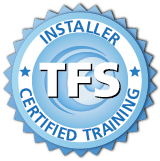
We have three convenient options:
Option 1 – Use your tools and equipment, listen to online lectures, complete the hands-on labs, and take the exam online.
Option 2 – Purchase the necessary tools and equipment from The Fiber School and save thousands compared to the list price, listen to online lectures, complete the hands-on labs, and take the exam online.
Option 3 – Borrow the necessary tools and equipment from The Fiber School, listen to the online lectures, complete the class, take the exam online, and return tools and equipment to The Fiber School
This fiber optic installation training course is designed for those who layout, install or maintain fiber optic cabling systems. It identifies you as a fiber optic installer able to demonstrate a practical knowledge of fiber optic theory, codes, standards and practices widely accepted in the fiber optics industry. In addition, this training incorporates individual, fully self-paced online, hands-on training validating fiber optic installer skills, including fiber terminations, cable preparations, fusion splicing, and optical loss testing. These skills are applicable to all the requirements to safely and competently install, maintain and test fiber optic cabling systems. The course provides step by step video instruction of how to preform each lab successfully. Once completed the student will upload a picture of the completed lab for professional review and grading. A lab manual is also provided in case the student wants written instructions.
Lectures are self-paced and provide valuable information that will help you pass the certification exam. Online access is accessible for 1 year from the date you register. The lecture portion of this class is online and self-paced through our Learning Management System. Students receive a personal login to the platform providing access to lectures, video lab directions, study guides, practical exam, practice tests and technical exam. Lectures aid in the hands-on lab portion of the course. Each student will take a 75-question multiple choice test and if they pass, they will receive their certification in 2-3 weeks. The exam will be completed through remote proctoring on the eta website via the following link Test Sites And Course-Approved Schools.
Students must pass exam to be certified.
ETA FOI Certification $155
Provide the student with the necessary knowledge and skills to:
Lectures are self-paced and provide valuable information that will help you pass the certification exam. Online access is accessible for 1 year from the date you register. The lecture portion of this class is online and self-paced through our Learning Management System. Students receive a personal login to the platform providing access to lectures, study guides, practical exam, practice tests and technical exam. Lectures aid in the hands-on lab portion of the course. Each student will take a 75-question multiple choice test and if they pass, they will receive their certification in 2-3 weeks. The exam will be completed through remote proctoring on the eta website via the following link Test Sites And Course-Approved Schools. Approximate time needed to complete lectures: 16 hours.
TL-01B – OSP Loose Tube Armored Cable Preparation
TL-01E – Buffer Tube Fan Out Kit (BTFO)
TL-02A – Fusion Splicing
TL-03A – Mechanical Splice Connector
TL-04A – Mechanical Splice
TL-05A – Pigtail Fusion Splice
TL-06A – Power Meter & Light Source Testing
Knowledge or experience in the areas of Fiber Optic Advantages and Applications, Cables, Connectors and Terminations, Enclosures and Panels, and Test Equipment would be helpful, but is not required.
Certified Fiber Installer is designed for new or experienced personnel seeking a deeper understanding of the installation of fiber optic cabling systems. This course is excellent for anyone involved in the construction, education, commercial, industrial, or utility markets and anyone who designs, installs, maintains, or tests fiber optic cabling systems.
TOOLS AND SUPPLIES REQUIRED FOR THIS COURSE
This course is offered online through our Digital Chalk Virtual Learning Management Service. Call (877) 529-9114 or email training@fiberoptic.com for registration information.
Remember, if you have 5 or more students, we can bring our class to you at your own facility – saving you time and money!
Any of our courses can be customized to focus on your needs – like using specific equipment, or working in a particular situation.
We reserve the right to cancel any course. A full refund will be provided unless the student elects to transfer to another course or time.
No refunds will be granted for student cancellation, but substitutions are permitted.